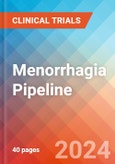Menorrhagia Understanding
Menorrhagia: Overview
Menorrhagia is heavy or prolonged menstrual bleeding that lasts for more than 7 days. It limits normal activities, affects quality of life, and causes anaemia in two-thirds of women with objective menorrhagia. It can be caused due to:1. Problems related to uterine
- Growths or tumors of the uterus that are not cancer; these can be called uterine fibroids or polyps.
Certain types of birth control - for example, an intrauterine device (IUD).
Problems such as a miscarriage or ectopic pregnancy, can also cause abnormal bleeding.
2. Hormone-related problems
3. Other illnesses
- Bleeding-related disorders, such as von Willebrand disease (VWD) or platelet function disorder.
Symptoms
Signs and symptoms of menorrhagia may include:
- Soaking through one or more sanitary pads or tampons every hour for several consecutive hours
- Needing to use double sanitary protection to control your menstrual flow
- Needing to wake up to change sanitary protection during the night
- Bleeding for longer than a week
- Passing blood clots larger than a quarter
- Restricting daily activities due to heavy menstrual flow
- Symptoms of anemia, such as tiredness, fatigue or shortness of breath
Diagnosis
Usually, menstrual bleeding lasts about 4 to 5 days and the amount of blood lost is small (2 to 3 tablespoons). However, women who have menorrhagia usually bleed for more than 7 days and lose twice as much blood. The doctor will ask about the medical history and bleeding cycles. The diagnosis involves one or more tests or procedures such as: blood test, pap test, endometrial biopsy, and ultrasound. Based on the results of primary tests, further tests such as Sonohysterography and Hysteroscopy can be recommended.Treatment
The type of treatment is based on the cause of bleeding and its severity. Other factors such as age, medical history and overall health will also be considered. Treatment for hormone problems may include: Prostaglandin inhibitors are nonsteroidal anti-inflammatory medicines (NSAIDs), including aspirin or ibuprofen. They help reduce cramping and the amount you bleed. Ablation, Hysterectomy Birth control pills helps to stop ovulation and result in lighter periods. Treatment for problems with the uterine lining (endometrium), hysterectomy, and iron supplementsMenorrhagia Emerging Drugs Chapters
This segment of the Menorrhagia report encloses its detailed analysis of various drugs in different stages of clinical development, including phase II, I, preclinical and Discovery. It also helps to understand clinical trial details, expressive pharmacological action, agreements and collaborations, and the latest news and press releases.Menorrhagia Emerging Drugs
Elagolix: Abbvie
Elagolix is an orally-administered, nonpeptide, small molecule gonadotropin-releasing hormone (GnRH) receptor antagonist that inhibits endogenous GnRH signaling by binding competitively to GnRH receptors in the pituitary gland. Administration results in dose-dependent suppression of luteinizing hormone (LH) and follicle-stimulating hormone (FSH), leading to decreased blood concentrations of the ovarian sex hormones estradiol and progesterone. It is registered for menorrhagia.Menorrhagia: Therapeutic Assessment
This segment of the report provides insights about the different Menorrhagia drugs segregated based on following parameters that define the scope of the report, such as:Major Players in Menorrhagia
There are approx. 5+ key companies which are developing the therapies for Menorrhagia. The companies which have their Menorrhagia drug candidates in the mid to advanced stage, i.e. phase III and Phase II include, Abbvie and others.Phases
The report covers around 10+ products under different phases of clinical development like
- Mid-stage products (Phase II and Phase I/II)
- Early-stage products (Phase I/II and Phase I) along with the details of
- Pre-clinical and Discovery stage candidates
- Discontinued & Inactive candidates
Route of Administration
Menorrhagia pipeline report provides the therapeutic assessment of the pipeline drugs by the Route of Administration. Products have been categorized under various ROAs such as- Subcutaneous
- Intravenous
- Oral
- Intramuscular
Molecule Type
Products have been categorized under various Molecule types such as
- Small molecules
- Natural metabolites
- Monoclonal antibodies
Product Type
Drugs have been categorized under various product types like Mono, Combination and Mono/Combination.Menorrhagia: Pipeline Development Activities
The report provides insights into different therapeutic candidates in phase II, I, preclinical and discovery stage. It also analyses Menorrhagia therapeutic drugs key players involved in developing key drugs.Pipeline Development Activities
The report covers the detailed information of collaborations, acquisition and merger, licensing along with a thorough therapeutic assessment of emerging Menorrhagia drugs.Report Highlights
The companies and academics are working to assess challenges and seek opportunities that could influence Menorrhagia R&D. The therapies under development are focused on novel approaches to treat/improve Menorrhagia.Menorrhagia Report Insights
- Menorrhagia Pipeline Analysis
- Therapeutic Assessment
- Unmet Needs
- Impact of Drugs
Menorrhagia Report Assessment
- Pipeline Product Profiles
- Therapeutic Assessment
- Pipeline Assessment
- Inactive drugs assessment
- Unmet Needs
Key Questions
Current Treatment Scenario and Emerging Therapies:
- How many companies are developing Menorrhagia drugs?
- How many Menorrhagia drugs are developed by each company?
- How many emerging drugs are in mid-stage, and late-stage of development for the treatment of Menorrhagia?
- What are the key collaborations (Industry-Industry, Industry-Academia), Mergers and acquisitions, licensing activities related to the Menorrhagia therapeutics?
- What are the recent trends, drug types and novel technologies developed to overcome the limitation of existing therapies?
- What are the clinical studies going on for Menorrhagia and their status?
- What are the key designations that have been granted to the emerging drugs?
Key Players
Abbvie
Key Products
- Elagolix
This product will be delivered within 2 business days.
Table of Contents
Companies Mentioned (Partial List)
A selection of companies mentioned in this report includes, but is not limited to:
- Abbvie








